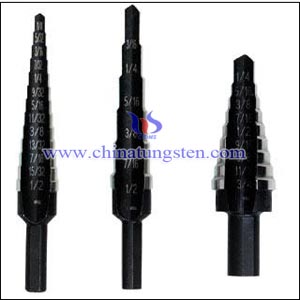Tungsten Carbide Step Drill bits Ⅲ
- Details
- Category: Tungsten Information
- Published on Wednesday, 18 November 2015 15:46
In last part we know that tungsten carbide step drill bits can drill an entire range of holes usually on softer material or sheet metal less than 1/4 inch thick. In this part we talk about the usage and advantage of this kind of bit.
Tungsten carbide step drill bits are ideal for use in electrical work where thin steel, aluminum or plastic boxes and chassis are encountered. The short length of the step drill bit and ability to vary the diameter of the finished hole is an advantage in chassis or front panel work. The finished hole can often be made quite smooth and burr-free, especially in plastic.
An additional use of tungsten carbide step drill bits is deburring holes left by other bits, as the sharp increase to the next step size allows the cutting edge to scrape burrs off the entry surface of the workpiece. However, the straight flute is poor at chip ejection, and can cause a burr to be formed on the exit side of the hole, more so than a spiral twist drill bit turning at high speed.
The step drill bit was invented by Harry C. Oakes and patented in 1973. It was sold only by the Unibit Corporation in the 1980s until the patent expired, and was later sold by other companies.

(To be continued. This article is divided into 5 parts. Here is part 3. For part 2, please refer to http://news.chinatungsten.com/en/tungsten-information/80508-ti-10401; for part 4, please refer to http://news.chinatungsten.com/en/tungsten-information/80510-ti-10404)
| Tungsten Carbide Supplier: Chinatungsten Online tungsten-carbide.com.cn | Tel.: 86 592 5129696; Fax: 86 592 5129797;Email:sales@chinatungsten.com |
| Tungsten News&Tungsten Prices, 3G Version: http://3g.chinatungsten.com | Molybdenum News & Molybdenum Price: http://news.molybdenum.com.cn |



 sales@chinatungsten.com
sales@chinatungsten.com